This is the second in a series of four blogs about the Postsecondary State Career Technical Education Leaders Fellowship at Advance CTE – Sponsored by ECMC Foundation and offers a review of several states’ Career Technical Education (CTE) leadership training initiatives and current efforts to diversify the pool of qualified candidates, specific to racial diversity.
In the first blog of this series, Advancing Equity in CTE: Making the Case for Diverse Leadership Pipelines in Career Technical Education, we shared data that highlighted the increase of diversity of learners in CTE programs and in comparison, the reality that state CTE leadership has remained mostly White, with approximately 13 percent of State CTE Directors identifying as non-White. As we seek to achieve a more demographically representative state CTE leadership, as called for in Without Limits: A Shared Vision for the Future of Career Technical Education (CTE Without Limits), this blog reviews the state of the CTE leadership pipeline in three states – Pennsylvania, Texas and Ohio. These states can both serve as exemplars and a starting point to evaluate the needs of state CTE systems to create more robust and diverse talent pipelines.
Overview
The current state of CTE leadership training programs vary based on state requirements to become a CTE administrator and how states and organizations without certification or licensure requirements decide to offer training opportunities. As of 2017 only 16 states require CTE administrators to attain a certification or licensure to teach at the secondary level. In the postsecondary space, the number of institutions of higher learning offering coursework specific to administrating and leading a CTE program are consistently declining; just nine states offer formal preparation programs 1. Administrative training for CTE is increasingly being offered in the form of mentorship programs, contracted hybrid virtual training typically modules, conference workshops or training academies offered by state CTE agencies and CTE affiliated organizations.
 Pennsylvania
Pennsylvania
The state offers leadership training through centers supported by the Pennsylvania Department of Education (PDE) at three sites, the state’s eastern site is located at Temple University, the central site is located at Penn State University and the western site is located at Indiana University of Pennsylvania. The programs offer a CTE Director’s Certificate for grades 7-12 which can be completed in two years and a Master of Education degree option in a virtual setting with a window of completion of two to three years. Additional or alternative training in the form of mentorship programs and conference workshops is also available through the Pennsylvania Department of Education Bureau of Career and Technical Education (BCTE) and the Pennsylvania Association for Career and Technical Administrators (PACTA). These efforts are bolstered by the requirement as mandated by the Pennsylvania Legislature and facilitated through the PA Inspired Leadership (PIL) Program for a CTE administrator to complete a certification process, Praxis Series School Leaders Licensure Assessment. A recent effort to establish CTE leadership standards is the development of a set of knowledge and skill core competencies (KSCC) resulting from the triangulated research conducted at Penn State University 2. The core competencies addressed are:
- Workforce Education Management
- Curriculum and Instructional Leadership in Workforce Education
- Fiscal and Facilities Management
- Ethical Issues in Workforce Education
- Administering Personnel Services
- History and Philosophy of Workforce Education
- The Law and Education
To date, the PDE has requested alignment between the research-developed KSCCs and the CTE Director Certificate offered in Pennsylvania.
 Texas
Texas
Secondary CTE administrator training in Texas is offered by the Texas Education Agency (TEA) and the Career & Technical Association of Texas (CTAT). The New CTE Administrator and Counselor Sessions, professional training modules provided to local education agencies by the TEA at no cost, focuses on preparing administrators to develop CTE systems aligned to the state’s college, career and military readiness (CCMR) standards ensuring access and equity in CTE programming. The NextGen Administrators, training designed for mid-level administrators such as CTE coordinators, specialists and instructional coaches with less than five years of experience, is a virtual option offered by CTAT with aspiring leaders meeting on a monthly basis for 13 months. The program explicitly lists as session topics Terminology and Best Practices in Cultural Diversity and Differentiated Instruction for Special Populations. The state agency no cost training was provided through the use of the state’s Carl D. Perkins Act leadership funds.
 Ohio
Ohio
The Ohio Association for Career and Technical Education supports CTE administrators for secondary and postsecondary leadership through the Byrl R. Shoemaker CTE Institute. A one-year hybrid program which includes beginning and ending with a legislative seminar, site visits to secondary LEAs and local higher education institutions, conference attendance, networking opportunities with local and state leaders and the completion of a team project.
Diversification of the CTE Talent Pipeline
While the states reviewed do not specifically outline a process to recruit diverse aspiring CTE administrators, leadership pipeline training opportunities are accessible and prominently featured on state and CTE support organizations’ websites. As identified in the first blog of this series and in alignment with CTE Without Limits Principle 2, the nation’s rapidly changing demographics create a sense of urgency related to the intentional recruitment of diverse leaders into the currently limited administrator pipelines available to CTE professionals.
In the next blog in this series, we will explore how state CTE leaders can (and why they should) lead with an equity lens. To learn more about the need for equity in CTE, visit Making Good on the Promise: Understanding the Equity Challenge in CTE in the Advance CTE Resource Center.
Read the full blog series
Blog 3: Advancing Equity in CTE: The Equity-Minded Leadership Framework
Blog 4: Advancing Equity in CTE: Administrative Policy Review – An Assessment of Equitable Practices
Dr. Kevin Johnson, Sr., Senior Advisor
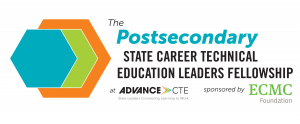


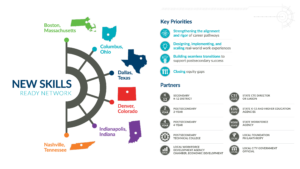
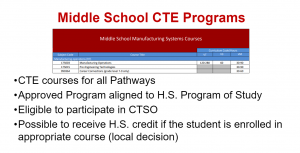 Career advising and development supports geared towards middle grades learners to improve access and achieve high-quality and equitable secondary CTE programs prove to be an early opportunity to develop an occupational identity and better build social capital. Ohio discussed the policy structures the state has put into place to support learners in CTE programs before they enter high school, including funding mechanisms and alignment of middle grades programs of study. Michigan Advance CTE-ECMC Fellow
Career advising and development supports geared towards middle grades learners to improve access and achieve high-quality and equitable secondary CTE programs prove to be an early opportunity to develop an occupational identity and better build social capital. Ohio discussed the policy structures the state has put into place to support learners in CTE programs before they enter high school, including funding mechanisms and alignment of middle grades programs of study. Michigan Advance CTE-ECMC Fellow 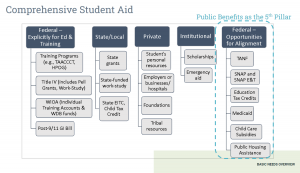 An education consultant and a state leader from Wisconsin provided an overview of programs that support learners basic needs, while elevating that many programs still create barriers for learners to complete credentials. Immediate next steps that were shared included making integrated benefits applications for federal assistance programs available online and inviting benefits coordinators to provide services on campus. Wisconsin highlighted their steps to create affinity groups with faculty and staff, with Dr. Colleen McCabe stating “To understand the effects of poverty, you have to explore learners’ multiple identities.”
An education consultant and a state leader from Wisconsin provided an overview of programs that support learners basic needs, while elevating that many programs still create barriers for learners to complete credentials. Immediate next steps that were shared included making integrated benefits applications for federal assistance programs available online and inviting benefits coordinators to provide services on campus. Wisconsin highlighted their steps to create affinity groups with faculty and staff, with Dr. Colleen McCabe stating “To understand the effects of poverty, you have to explore learners’ multiple identities.”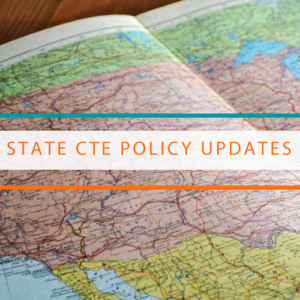 October 7 was National Manufacturing Day but, in Ohio, the celebration lasts the entire month. . Ohio uses this time to raise awareness of the various manufacturing pathways available to learners in the state and inspire those learners to join. Ohio already has significant investments in the manufacturing economy which generates more than $125 billion. However, knowledge of how many different skill sets and jobs are available in the industry is still not widespread. By taking advantage of Manufacturers Month, this post highlights the innovative ways Ohio is uplifting the manufacturing pathway as well as leveraging the support of The Ohio Manufacturers’ Association (OMA), which is bringing awareness to various grants and programs, some of which have been made recently available to Ohio residents.
October 7 was National Manufacturing Day but, in Ohio, the celebration lasts the entire month. . Ohio uses this time to raise awareness of the various manufacturing pathways available to learners in the state and inspire those learners to join. Ohio already has significant investments in the manufacturing economy which generates more than $125 billion. However, knowledge of how many different skill sets and jobs are available in the industry is still not widespread. By taking advantage of Manufacturers Month, this post highlights the innovative ways Ohio is uplifting the manufacturing pathway as well as leveraging the support of The Ohio Manufacturers’ Association (OMA), which is bringing awareness to various grants and programs, some of which have been made recently available to Ohio residents.  In August, the OMA was named one of the 32 finalists for the “
In August, the OMA was named one of the 32 finalists for the “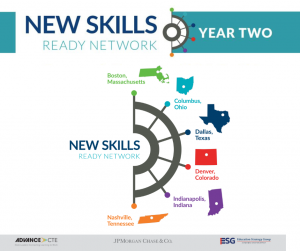 Today, Advance CTE and Education Strategy Group (ESG) released an annual report and site snapshots for year two of the
Today, Advance CTE and Education Strategy Group (ESG) released an annual report and site snapshots for year two of the 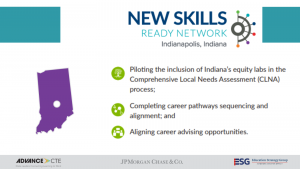
 Boston, Massachusetts,
Boston, Massachusetts, 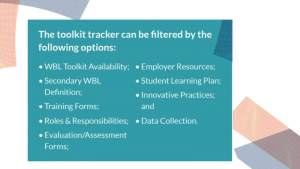
 On June 8, Advance CTE held the first of three events that encompass our Virtual June Meeting Series. The series offers three opportunities to equip Career Technical Education (CTE) leaders with the latest research and innovations, empower them to succeed, and elevate their work to raise awareness of the value of CTE.
On June 8, Advance CTE held the first of three events that encompass our Virtual June Meeting Series. The series offers three opportunities to equip Career Technical Education (CTE) leaders with the latest research and innovations, empower them to succeed, and elevate their work to raise awareness of the value of CTE. 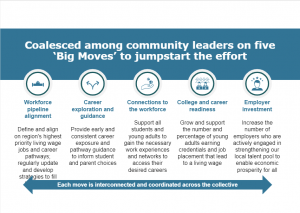 Dallas Foundation Chief Impact Officer Drexell Owusu was candid about the equity and quality of life challenges facing residents of Dallas. However, he was equally optimistic about the role that CTE can have in providing high-quality pathways to maximize recent economic growth and increase the number of young adults achieving a living wage to 50 percent within one generation. He identified five strategies that comprise the Dallas Thrives initiative to achieve this goal.
Dallas Foundation Chief Impact Officer Drexell Owusu was candid about the equity and quality of life challenges facing residents of Dallas. However, he was equally optimistic about the role that CTE can have in providing high-quality pathways to maximize recent economic growth and increase the number of young adults achieving a living wage to 50 percent within one generation. He identified five strategies that comprise the Dallas Thrives initiative to achieve this goal. 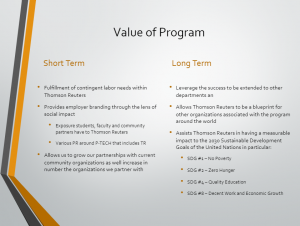 Thomson Reuters Director of Community Relations
Thomson Reuters Director of Community Relations 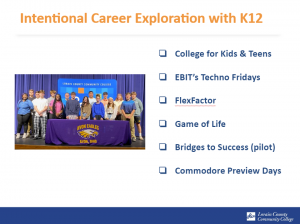 Lorain County Community College Manager of Career Technical Pathways & Programs
Lorain County Community College Manager of Career Technical Pathways & Programs  Without Limits: A Shared Vision for the Future of Career Technical Education
Without Limits: A Shared Vision for the Future of Career Technical Education